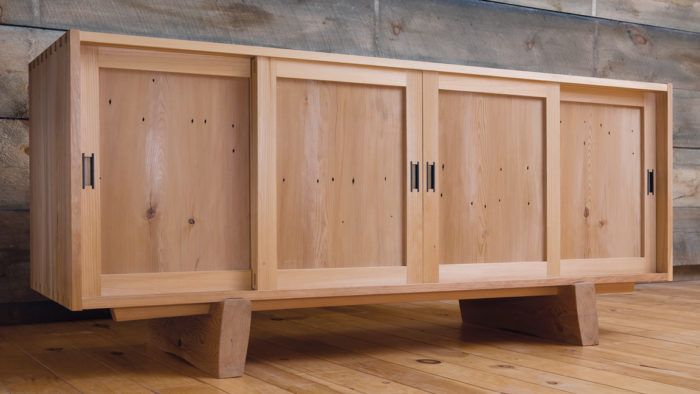Designer’s Notebook: A Finer Side of Pine
From blanket chests to tables to case pieces, his “fine pine line” is simple in style and modest in material
Synopsis: When Andrew Hunter builds furniture for his own house, in his own style, he typically builds it from pine. From blanket chests to tables to case pieces, his “fine pine line” is simple in style and modest in material. Yet don’t let the simplicity fool you. This furniture is built with skill, attention to detail, and style.
If I’m going to be frank, making custom furniture on commission is a hard gig. Every customer has different needs and it is my job to assess them and then design, shape, and deliver a piece to address them—without losing my shirt. In my commission work I build in many styles, but typically in a refined realm, with sophisticated designs and intricate joinery. That’s a lot to juggle.
I enjoy pushing my skills on these more complicated pieces, but in my heart I’m a simple person who prefers a more vernacular style. So lately I have been putting together my fine pine line—pieces ranging from blanket chests to tables to case pieces. Admittedly, one of the first things I have to work on is the name, but a “fine pine line” is exactly what it is. It’s a well-built series of pieces in my favorite wood: eastern white pine.

Eastern white pine is an amazing wood. I can source it locally in really wide boards for a fraction of the cost of other woods. It dries quickly with little distortion and when quartersawn, it ranks among the most stable woods in the world. Working with it is fun! With sharp tools, it cuts and planes like butter. Even the knots aren’t too cranky. And that’s good, because the heart of the pine line is its handplaned finish.
The line is much more affordable than my commission work. It’s more rustic in style, but it’s not built with any less skill or attention; the designs are fine-tuned and simplified. The joinery is sound but straightforward, and it’s never concealed if that would require more work. There are still dovetails, but there are also nails—old-fashioned cut nails of course. The ornamentation is plain, with plenty of tool marks left behind to remind the user that the piece had a maker. Although simple in design and modest in material, these pieces still emanate a well-built quality. This is the furniture I build for my own house, a self-portrait in wood.
A Wood that Looks Good in Many Styles
These are just a few examples from my line. The designs are influenced by classical forms, but also by more minimalist, modern ones, and the pieces are sweetened up with a handplane finish.
The hutch design (p. 28) has its origins in American pieces from the 17th century. It is white pine, with red oak details. They are both humble woods, and the colors of the knots in the pine go well with the red of the oak. The back boards are finished with milk paint, with a coat of darker blue underneath the finish coat. The finished surface is lightly sanded, exposing patches of the darker blue below.

The blanket chest (left) is Shaker influenced, and its form showcases nice, wide boards. I realized after making this prototype I would rather have red oak knobs. That is another nice thing about producing a line—I have many more chances to get it just right.
The credenza design draws from Japanese influence. The case is white pine joined with exposed dovetails. The interior dividers are attached to the case with sliding dovetails, which lock the whole case together. Door panels are a place to add individuality to a piece, and here the sliding doors have pine frames and old hemlock barn board panels, with blackened nail holes flowing across all the doors.
To read the complete article, download the PDF below.
More on FineWoodworking.com:
- Video Workshop: Country Pine Hutch – In this video workshop, join furniture maker Andrew Hunter as he takes you through the entire process of building a classic pine hutch using traditional hand tools.
- Blanket Chest by Hand – Hand tools and white pine make it a treat to build this country classic
- Best Finish for Pine – Thin layers of shellac and stain add age and warmth without blotching
Fine Woodworking Recommended Products

Stanley Powerlock 16-ft. tape measure

Drafting Tools

Ridgid R4331 Planer
























Comments
Thanks for a great article Andrew. Like you - I always favored the simple, even a minimalist look. I love all woods, but you can't beat pine.
Log in or create an account to post a comment.
Sign up Log in